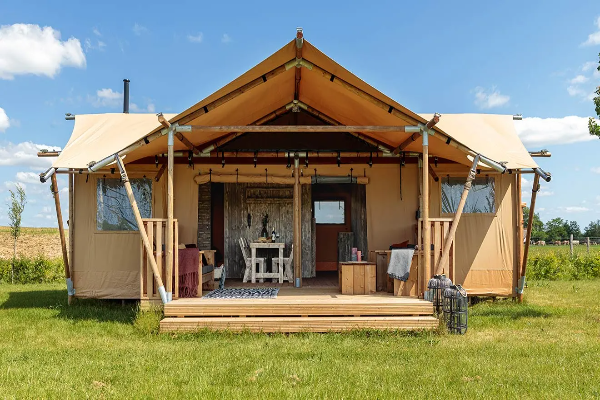A safari tent is a type of accommodation designed for outdoor adventures. It combines the comforts of home with the experience of camping. Safari tents are popular in locations like national parks, wildlife reserves, and luxury camping sites. They offer a blend of nature and luxury.
History of Safari Tents
Safari tents originated from traditional African safari camps. They were used by early explorers and hunters. Over time, they evolved into more comfortable and luxurious options for travelers. Modern safari tents are much more advanced than their historical counterparts.
Design and Structure
Basic Design
Safari tents typically have a canvas exterior. They are supported by a frame, which can be made of wood or metal. The frame allows the tent to stand upright and provide shelter. The canvas is usually waterproof and durable.
Interior Layout
Inside, safari tents can vary greatly. Some have simple setups with basic furnishings. Others feature high-end amenities like beds, furniture, and private bathrooms. The interior often includes:
Sleeping area: Comfortable beds or mattresses.
Living area: Chairs, tables, and sometimes a small kitchenette.
Bathroom: Some safari tents have en-suite bathrooms with showers and toilets.
Luxury Features
Modern safari tents may include luxury features such as:
Electricity: For lighting and charging devices.
Air Conditioning/Heating: To maintain comfort in different weather conditions.
Decking: Wooden or composite decks for outdoor relaxation.
Advantages of Safari Tents
Comfort and Convenience
Safari tents offer a higher level of comfort compared to traditional camping tents. They often include:
Comfortable beds: With high-quality linens and pillows.
Furniture: Such as chairs, tables, and storage units.
Climate Control: To manage temperature and humidity.
Connection to Nature
Despite their luxury, safari tents maintain a strong connection to nature. They are often placed in scenic locations with views of wildlife and landscapes. This allows guests to enjoy the outdoors while still having comfortable accommodations.
Flexibility
Safari tents can be set up in various locations, making them versatile. They can be used in:
National Parks: Offering close proximity to wildlife.
Beachfronts: For a relaxing seaside experience.
Mountain Areas: Providing a unique high-altitude experience.
Types of Safari Tents
Classic Safari Tents
These are traditional designs that provide basic amenities. They are often used in budget-friendly safari camps. Classic safari tents may include:
Basic furnishings: Such as a bed and simple storage.
Shared facilities: Bathrooms and dining areas might be shared with other guests.
Luxury Safari Tents
Luxury safari tents are equipped with high-end features and amenities. They cater to guests seeking a more upscale experience. Features may include:
En-suite bathrooms: With showers and toilets.
High-quality furnishings: Including comfortable beds and stylish decor.
Private verandas: For personal outdoor space.
Glamping Safari Tents
Glamping (glamorous camping) tents combine luxury and outdoor adventure. They often include:
High-end bedding: With plush mattresses and premium linens.
Fully equipped kitchens: With appliances and cookware.
Stylish decor: Creating a chic and comfortable atmosphere.
Setting Up a Safari Tent
Choosing a Location
Selecting the right location is crucial for a safari tent. Consider:
Scenery: Choose a spot with a view of natural landscapes or wildlife.
Accessibility: Ensure the site is easy to reach and has necessary amenities nearby.
Weather: Check the local climate to ensure the tent can handle expected conditions.
Installation
Setting up a safari tent involves:
Preparing the Site: Clear the area of debris and level the ground.
Assembling the Frame: Follow the manufacturer’s instructions for proper setup.
Securing the Canvas: Ensure the tent is firmly attached to the frame and anchored to the ground.
Maintenance
Regular maintenance is essential to keep a safari tent in good condition. This includes:
Cleaning: Regularly clean the interior and exterior of the tent.
Checking for Damage: Inspect the canvas and frame for any signs of wear or damage.
Repairing: Address any issues promptly to avoid further damage.
Popular Destinations for Safari Tents
Africa
Africa is renowned for its safari tents, especially in countries like Kenya, Tanzania, and South Africa. Popular locations include:
Maasai Mara: Known for its abundant wildlife and stunning landscapes.
Serengeti: Famous for the Great Migration and diverse wildlife.
Kruger National Park: Offers a range of safari tent options in a vast wilderness.
Other Regions
Safari tents are also found in other regions, such as:
Australia: In places like the Outback and tropical rainforests.
North America: In national parks and wilderness areas.
Europe: In scenic locations such as the French Alps or Italian countryside.
Cost of Safari Tents
Budget Options
Budget safari tents are more affordable and provide basic amenities. Prices can range from $50 to $150 per night, depending on location and season.
Mid-Range Options
Mid-range safari tents offer additional comfort and features. Prices typically range from $150 to $300 per night.
Luxury Options
Luxury safari tents can be quite expensive, with prices ranging from $300 to $800 or more per night. These tents offer high-end amenities and exceptional comfort.
See Also: What Do You Need to Go Camping in the Woods
Conclusion
Safari tents offer a unique blend of adventure and comfort. They allow you to experience the outdoors without sacrificing the luxuries of home. Whether you choose a classic, luxury, or glamping safari tent, you can enjoy a memorable and comfortable stay in beautiful natural settings.

